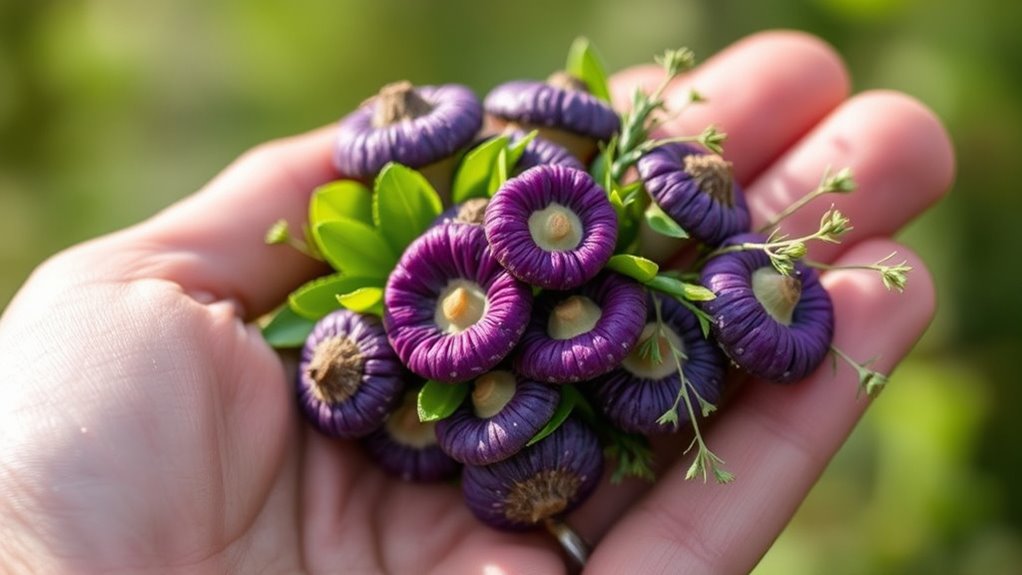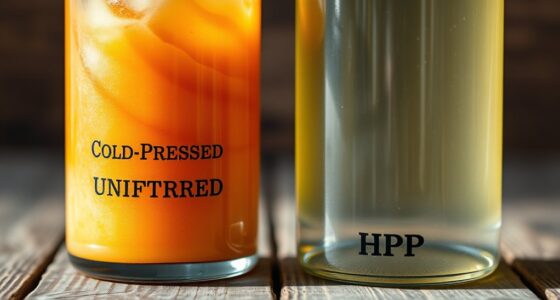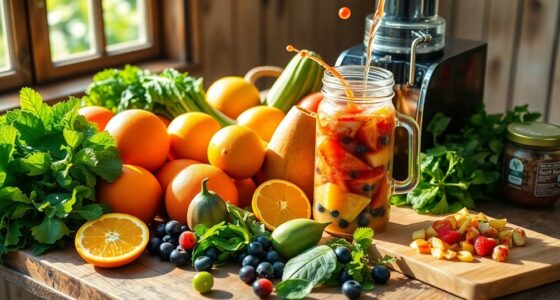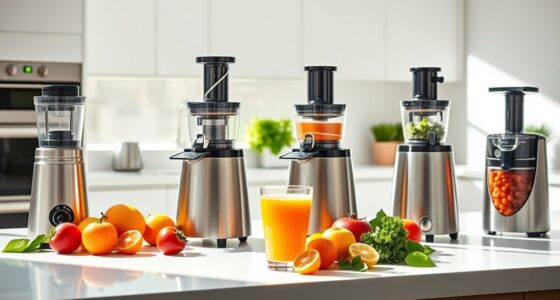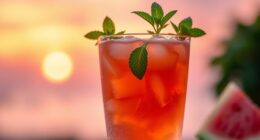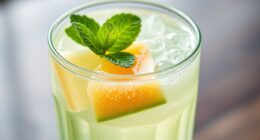When foraging wild ingredients, it’s essential to identify plants and fungi accurately using reliable guides and visual cues. Start with known edible species and avoid contaminated areas near roads or factories. Use proper tools and gentle techniques for harvesting, and test samples before consumption to stay safe. Always check local regulations and respect ecosystems. If you want to stay safe and responsible, following these tips will help you enjoy foraging wisely and sustainably.
Key Takeaways
- Properly identify plants and fungi using visual cues, reliable resources, and expert guidance to avoid toxic look-alikes.
- Use trusted field guides and consult professionals before consuming unknown wild ingredients.
- Start with easily recognizable, widely edible species and expand knowledge gradually.
- Harvest only from safe, uncontaminated sites away from pollution sources and protected areas.
- Use clean, sharp tools and perform small toxicity tests to ensure safety before full consumption.
Learn to Identify Plants and Fungi Correctly

How can you safely enjoy wild foraging if you don’t know how to identify plants and fungi? The key is mastering plant identification and fungal recognition. Start by learning the distinctive features of edible species—leaf shape, color, texture, and growth patterns. Pay close attention to details like smells and how plants or fungi grow in their natural environment. Avoid assumptions based on looks alone, as many edible plants have toxic look-alikes. Practice caution and never consume anything unless you’re absolutely sure it’s safe. Developing your ability to recognize edible species and distinguish them from harmful ones is essential for safe foraging. Educating yourself about state-specific benefits and local regulations can also help you forage responsibly and legally. Incorporating proper storage techniques—such as refrigeration or dehydration—can help you prevent misidentification and spoilage, ensuring your foraged foods remain safe to eat. Understanding plant and fungus habitats and their preferred growing conditions further enhances your ability to identify safe foraging options. This knowledge forms the foundation for a rewarding and safe wild-food experience.
Use Reliable Field Guides and Resources
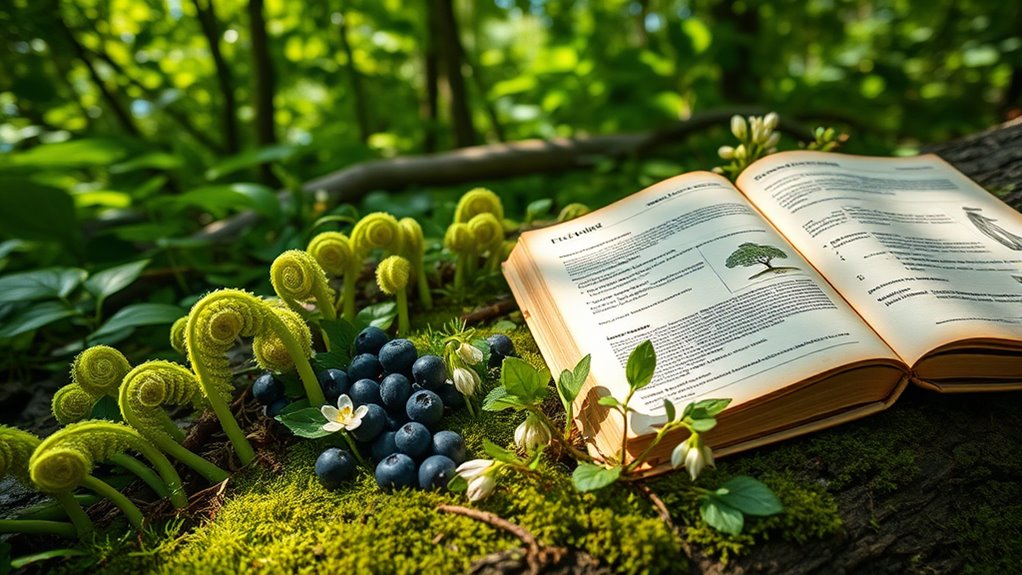
Using reliable field guides and resources is essential for accurate plant and fungi identification during your wild foraging adventures. These tools help you understand plant taxonomy, clarifying species differences and reducing the risk of misidentification. When it comes to mushroom identification, precise guides are vital since many edible and toxic varieties look alike. Invest in reputable, up-to-date books or digital apps that include detailed descriptions, photographs, and habitat information. Cross-reference multiple sources to confirm identifications before harvesting. Reliable resources also teach you about seasonal changes and regional differences, making your foraging safer. Remember, even experienced foragers rely on trusted guides—never guess or assume a plant or fungus is safe based on limited knowledge. Your safety depends on thorough, accurate identification. Incorporating somatic awareness techniques can also enhance your focus and attentiveness during the foraging process, reducing errors and increasing safety. Developing a trust in reputable sources is crucial, especially as AI-driven tools are increasingly integrated into expert identification practices. Additionally, understanding Glycolic Acid benefits can serve as a reminder of the importance of accurate information when selecting skincare products or natural remedies. Moreover, cultivating attention to detail is a key trait of successful foragers, as it helps in distinguishing subtle differences among species. Staying informed through scientific studies and updates ensures your knowledge remains current and reliable.
Start With Known Edible Species

Starting your foraging journey with known edible species is the safest way to build confidence and skills. Focus on common edible plants that are easy to identify and widely recognized as safe. Known species, like wild berries, wild greens, or mushrooms, provide a solid foundation for beginners. Familiarity with these plants helps you avoid accidental poisoning and develop your identification skills. Use reliable field guides or resources to confirm the species you find, and learn their distinctive features. Sticking to known species minimizes risks and allows you to enjoy foraging responsibly. As you gain experience, you can expand your knowledge to less common edible plants. Always remember, starting with known species keeps your foraging safe and enjoyable.
Avoid Foraging in Polluted or Contaminated Areas
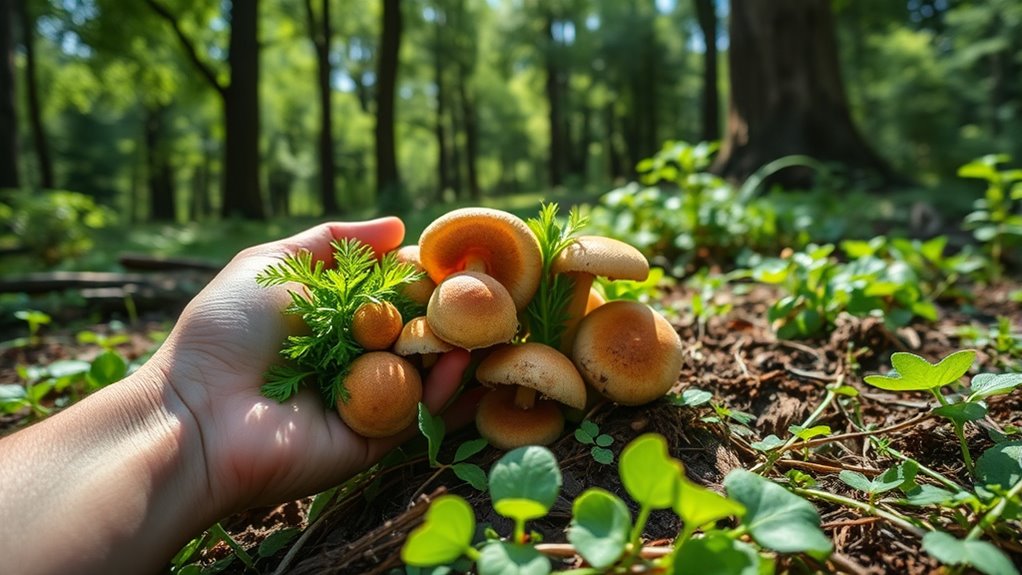
To guarantee your foraged ingredients are safe, you must avoid collecting plants from polluted or contaminated areas. Pollution risks come from nearby factories, busy roads, or waste sites, which can introduce harmful chemicals into soil and water. Contamination sources such as pesticides, heavy metals, or sewage runoff can settle into plants, making them unsafe to eat. Always scout for foraging sites away from known pollution sources, and check local advisories about contaminated areas. Even seemingly pristine locations might be affected by environmental pollution, so it’s crucial to verify the safety of the area before harvesting. Because environmental pollution can be compromised by environmental factors, ensuring your foraging sites are clean helps maintain the safety and quality of your ingredients. Additionally, understanding the pollution sources in an area can help you identify safer locations for foraging. Being aware of environmental contaminants can further guide you in choosing safer foraging spots. By steering clear of polluted zones, you reduce the risk of ingesting toxins and ensure your foraged ingredients are healthy and safe. It is also helpful to recognize soil contamination signs that may indicate unsafe growing conditions for edible plants.
Use Proper Tools and Techniques for Harvesting
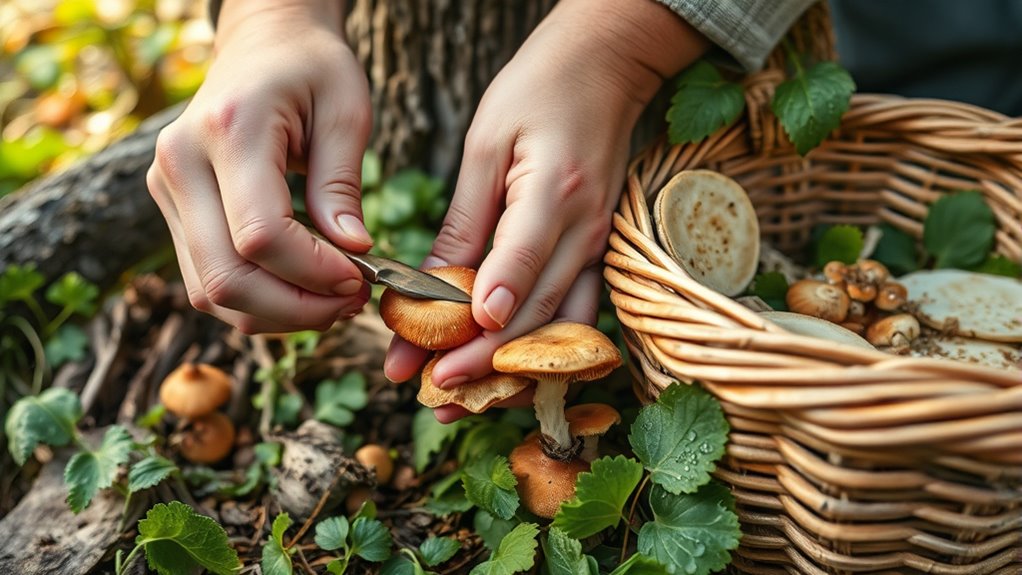
Employing the right tools and techniques is essential to harvesting wild ingredients responsibly and efficiently. Using proper harvesting techniques guarantees you get the best quality without damaging the environment. Always prioritize tool safety to prevent accidents. Here are three tips to help you:
Using proper tools and techniques ensures safe, responsible, and high-quality wild ingredient harvesting.
- Choose sharp, clean tools suited for the specific plant, like scissors for herbs or a knife for mushrooms.
- Use gentle, precise movements to avoid damaging the plant or overharvesting.
- Store tools properly after use to maintain their safety and effectiveness.
Perform Safety Tests Before Consumption
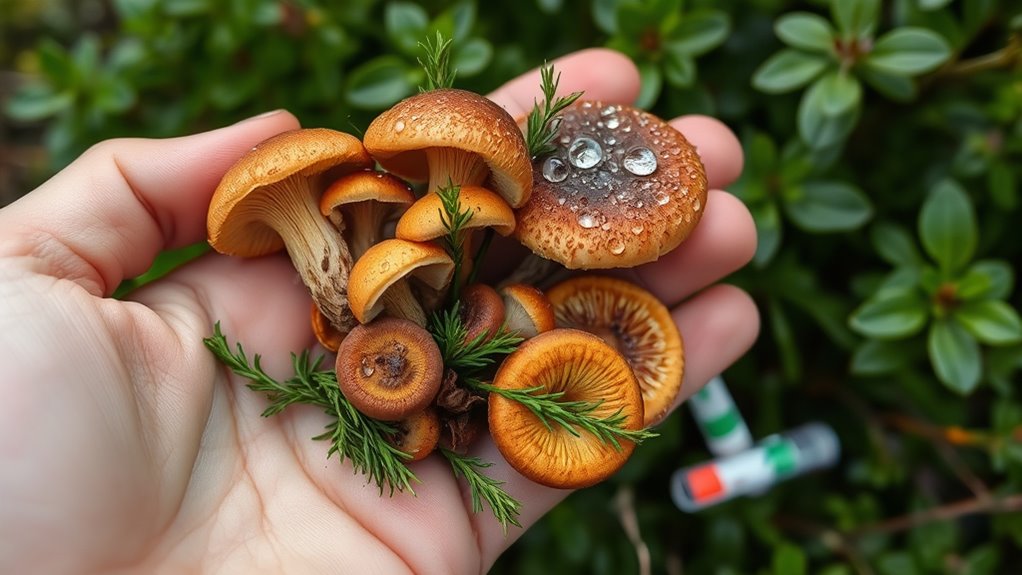
Before consuming wild-foraged ingredients, it’s essential to perform safety tests to prevent potential poisoning or health issues. Start with toxicity testing by small, controlled samples to check for adverse reactions or unusual tastes. This helps identify harmful substances or toxins that may not be obvious. Additionally, allergen screening is indispensable, especially if you have known allergies. Test for allergic reactions by applying a small amount to your skin or consuming a tiny portion first. Keep in mind that even edible-looking plants can be toxic, so thorough testing is indispensable. Always research the specific plant or mushroom beforehand and follow any recommended safety procedures. Incorporating proper identification techniques and safe foraging practices is crucial to avoid dangerous mistakes. Developing proper identification techniques is crucial to avoid dangerous mistakes. Taking these precautions can help guarantee your foraged ingredients are safe and enjoyable to eat. Additionally, staying informed about the latest AI-assisted identification tools can enhance the accuracy of your foraging efforts.
Be Aware of Local Regulations and Restrictions
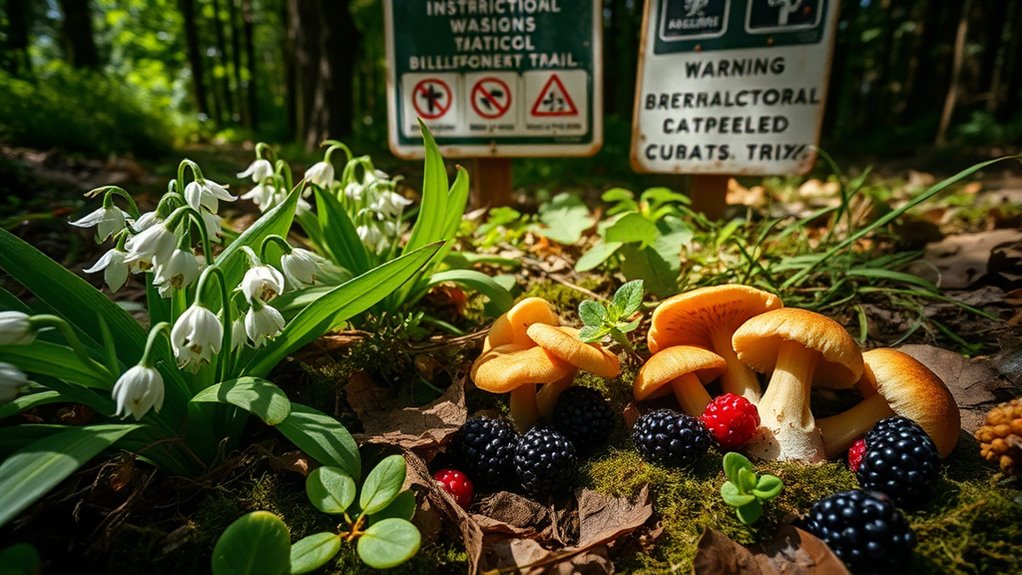
Before foraging, you need to check local laws to stay within legal boundaries. Make sure you respect protected species and avoid harm to the environment. If required, obtain permits to forage responsibly and avoid legal trouble. Additionally, be aware of regulated areas where foraging might be restricted or prohibited. Being familiar with local regulations can help prevent inadvertent violations and promote sustainable harvesting practices. Understanding legal considerations can further support responsible harvesting practices. Foraging in protected habitats without proper authorization can lead to penalties and ecological damage. Understanding off-road vehicle regulations, such as those for electric bikes and dirt bikes, can also help ensure you’re compliant if foraging takes place in areas where vehicle access is regulated.
Research Regional Laws
Understanding local laws and regulations is essential before foraging for wild ingredients, as rules can vary widely between regions. To stay compliant, you should:
- Research regional laws to identify any restrictions on foraging areas or species.
- Check if you need a foraging permit, especially for protected or private lands.
- Be aware of seasonal restrictions that may limit harvesting times or quantities.
Failing to follow these guidelines could lead to fines or legal issues. Many regions require permits to ensure sustainable foraging and protect native ecosystems. Always verify whether specific species are protected or if there are limitations on gathering from public or private land. Staying informed helps you forage responsibly and avoid unintended violations.
Respect Protected Species
Being aware of protected species is crucial when foraging, as many regions have laws that prohibit harvesting certain plants and animals to preserve biodiversity. Removing protected species can harm local ecosystems and lead to legal consequences. Always identify which species are off-limits and respect these restrictions to support conservation efforts. Practicing ethical harvesting means only taking what you need and avoiding any species that are protected or endangered. This approach ensures you don’t contribute to the decline of vulnerable populations and helps maintain ecological balance. Familiarize yourself with local regulations and signage, and err on the side of caution. By respecting protected species, you contribute to sustainable foraging and help preserve nature’s diversity for future generations.
Obtain Necessary Permits
To forage responsibly, you need to make certain you’re complying with local laws and regulations. Understanding the permitting process guarantees you stay within legal compliance and avoid fines. Here are three key steps:
- Check local regulations to identify if permits are required for foraging in your area.
- Contact the appropriate authorities or agencies to obtain necessary permits or permissions.
- Keep documentation of your permits handy, especially if you’re foraging on public or protected land.
Practice Ethical Foraging to Protect Ecosystems
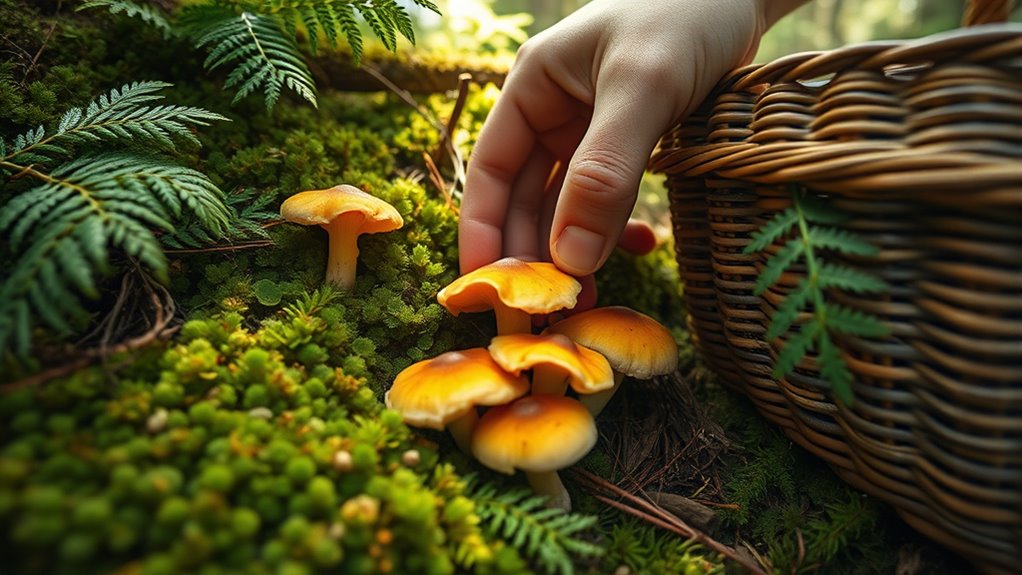
When foraging, you should respect protected areas and avoid harvesting there to help preserve delicate ecosystems. Always harvest responsibly and moderately to prevent overexploiting plant populations. Make sure you can correctly identify species to avoid harming endangered or toxic plants.
Respect Protected Areas
Respecting protected areas is essential when foraging, as it guarantees ecosystems remain healthy and resilient. To practice ethical harvesting and support habitat preservation, follow these steps:
- Obey local regulations—always check for restrictions and protected zones before foraging.
- Avoid overharvesting—collect only what you need and leave enough for wildlife and plant regeneration.
- Stay on designated trails—this minimizes habitat disturbance and helps preserve delicate ecosystems.
Harvest Responsibly and Moderately
Practicing ethical foraging means harvesting wild ingredients in a way that minimizes environmental impact. To support sustainable harvesting, only take what you need and avoid overharvesting. This helps ensure plants and fungi can regenerate naturally and continue thriving. Be mindful of the abundance of a species; if it’s scarce, skip it to prevent further decline. Moderation is key—don’t strip an area clean, allowing space for future growth. Respect local regulations and guidelines, which are designed to protect ecosystems. By harvesting responsibly, you reduce your footprint and help maintain healthy ecosystems for others to enjoy. Remember, your goal is to gather wild ingredients without harming the environment, ensuring they remain available for future foragers and wildlife alike.
Identify Species Correctly
To forage responsibly, it is vital to identify wild species accurately, ensuring you harvest only what’s safe and sustainable. Proper plant identification and mushroom recognition prevent accidental poisoning and protect ecosystems. To get it right, consider these steps:
- Study reliable guides and field books for detailed descriptions and images.
- Practice visual cues, like leaf shape, color, and texture, when identifying plants.
- Never pick mushrooms unless you’re 100% sure they’re edible; many toxic varieties resemble safe ones.
Always double-check your identifications, and when in doubt, consult experienced foragers or experts. This careful approach helps preserve the environment and keeps your foraging safe. Remember, misidentification can have serious consequences, so take the time to learn and verify every species before harvesting.
When in Doubt, Consult Experts
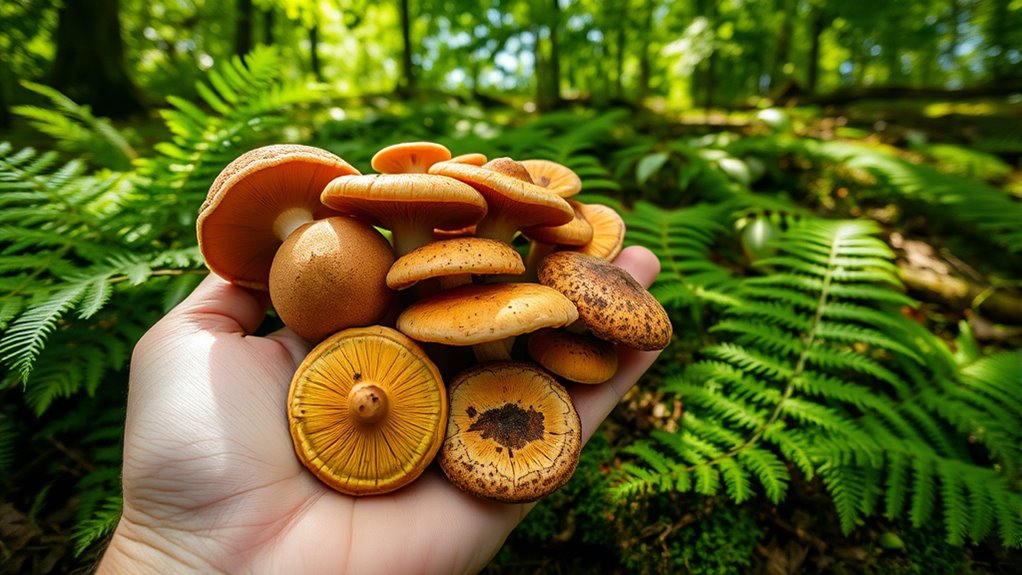
When you’re unsure about identifying a wild ingredient or its safety, consulting experts can prevent potential health risks. Misidentifying plants or fungi can lead to serious dangers of misidentification, including consuming toxic look-alikes. Experts, such as foragers or botanists, can help you distinguish safe species from harmful ones, reducing the risks of toxicity. Even experienced foragers sometimes encounter uncertain specimens; when in doubt, seeking professional advice is the safest choice. You shouldn’t rely solely on pictures or casual guides, as mistakes can be costly. Remember, the consequences of consuming a toxic wild ingredient can be severe, so never hesitate to ask for expert guidance. Prioritizing safety by consulting specialists helps ensure your foraging adventures remain enjoyable and risk-free.
Frequently Asked Questions
How Can I Distinguish Between Poisonous and Edible Look-Alikes?
You need to focus on accurate plant identification to tell edible look-alikes from poisonous ones. Use detailed field guides and compare features like leaf shape, color, and stem structure. Toxin testing kits can provide extra safety, especially when you’re unsure. Always double-check your findings, and when in doubt, avoid consuming any plant that might be risky. Proper identification guarantees your foraging remains safe and enjoyable.
Are There Seasonal Risks Associated With Foraging Certain Plants or Fungi?
Like the changing seasons, foraging comes with its own risks. You should be aware of seasonal plant variations and fungi growth cycles, which influence when certain plants and fungi are safe or hazardous. Spring and fall often bring different varieties, and fungi may be more toxic during specific growth phases. Staying informed about these seasonal patterns helps you avoid dangerous look-alikes and guarantees your foraging experience remains safe and enjoyable.
What Are Common Contaminants to Watch Out for in Wild Ingredients?
You should be aware of common contaminants like bacteria, pesticides, and heavy metals that can taint wild ingredients. Contaminant sources include polluted water, soil, or nearby industrial areas. To keep your foraged foods safe, follow safe handling practices like thorough washing, avoiding contaminated sites, and proper storage. These steps help reduce health risks, ensuring you enjoy wild ingredients without worry. Always stay vigilant about potential contaminants for your safety.
How Do I Safely Store Foraged Ingredients Before Use?
Oh, the thrill of foraging, but don’t let your treasures turn into a science experiment! To avoid contamination, you should use proper storage methods like airtight containers and keep your finds refrigerated or in cool, dark places. This way, you prevent bacteria growth and spoilage. Remember, proper storage methods aren’t just about keeping things fresh — they’re your first line of defense in contamination prevention. Stay smart, stay safe!
Can Foraging Be Safe for Children and Pets?
Foraging can be safe for children and pets if you take proper precautions. Always supervise kids and pets closely to prevent ingestion of toxic plants or unfamiliar items. Teach children about the importance of not touching or eating wild plants without your guidance. Keep foraged ingredients out of reach when not in use, and make sure your pets don’t access foraging areas. Prioritize child safety and pet protection to enjoy foraging responsibly.
Conclusion
Did you know that improper foraging can cause serious health issues or ecological damage? By following these safety tips, you reduce risks and help preserve nature’s resources. Remember, over 80% of wild plants and fungi are misidentified by beginners, leading to potential poisoning. Stay informed, always double-check your finds, and when unsure, consult experts. Safe foraging not only protects you but also guarantees these precious resources remain available for future generations.
Susannah expertise lies in researching and compiling evidence-based content on juicing, nutrition, and overall health. She is committed to ensuring that The Juicery World offers accurate, up-to-date, and trustworthy information to empower readers to take control of their health. Susannah’s goal is to inspire individuals to embrace juicing as a way to nourish their bodies and live their best lives.

